
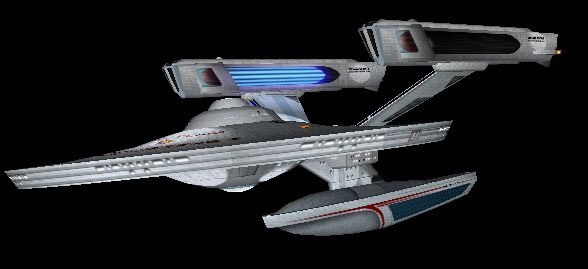 Clyde Fleet Shipyards
USS T'Lani NCC-3941
T'Lani-class science cruiser
Clyde Fleet Shipyards
USS T'Lani NCC-3941
T'Lani-class science cruiser
Owner/Operator: United Federation of Planets/Starfleet.
Type: Long-range/extended mission duration science vessel.
Availability: Limited. In service from 2275
Production Run: 40 ships, 2275-2280
Statistics
Length: 235.7m
Beam: 141.7m
Height: 73.9m
Armament
Phasers: Six (6) banks of paired Type-IV (Ph-3) emitters mounted on the saucer giving 720 degree arc;
Torpedoes: One (1) forward Hyde-York probe launcher/photon torpedo tube (as seen on Enterprise in 'STII:TWoK'); Firing rate: 2 per minute; Burst fire: N/A.
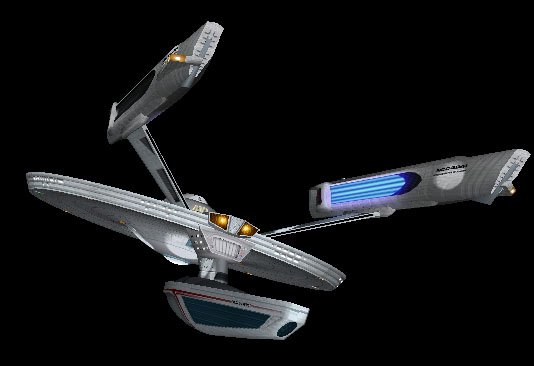 History - Development of the Science Cruiser Concept
History - Development of the Science Cruiser Concept
Starfleet first began to look at developing a full-sized science cruiser right after its inception on 2161. The Daedalus class was originally going to be a fully fledged science ship with minimal armaments and tactical staff. However, the nature of the geo-political climate after the incorporation of the Federation with the initial confrontations with the Klingons and the Earth-Romulan War squelched this original configuration at the early design meetings. A more versatile and capable layout was finally adopted that incorporated aspects of all expected mission roles the ship could be expected to perform as the flagship Federation class. This is a tradition that continues to this day, and Starfleet cruiser-type starships are the most capable and versatile in service in Known Space.
As such, pure science vessels evolved into small, specialised ships as demonstrated in the early T’Pina and current Oberth classes. A small crew of scientists would embark upon a small vessel that could be easily and quickly constructed at civilian-grade ship yards, and then packed with the most advanced sensors and computers available. This allowed many civilian institutions such as universities and research groups to put together their own teams to investigate and research their own pet projects, then allowed the ships to be switched to a different specialisation with a short period in a ship yard.
Starfleet too followed this trend for surveys of new planets, in which a planet discovered and assessed by their exploratory cruisers would be visited by a dedicated science vessel that would exhaustively catalogue each lifeform - plant, animal, bacterial, etc - to give the planet its Guarantee of Suitability so that Federation planners could release it for colonisation or development.
Starfleet also followed this pattern for surveys and investigations of stellar phenomena, but it was found that the specialised science vessels were too small for extended analysis. While the single-mindedness of scientists in pursuit of their research is well documented, it was discovered that too many of them crowded aboard these ships, leading to Oberth class ships with a nominal crew of 40 personnel being packed to the bulkheads with upwards of 80 people. This strained the small ships’ environmental systems to the limits and further reduced the time they could spend on-station. Further, lab and computer time had to be either conducted in large groups or on a very regulated schedule for personal/individual team access. The spirit of scientific cooperation helped to defuse many pending ego-fuelled tirades.
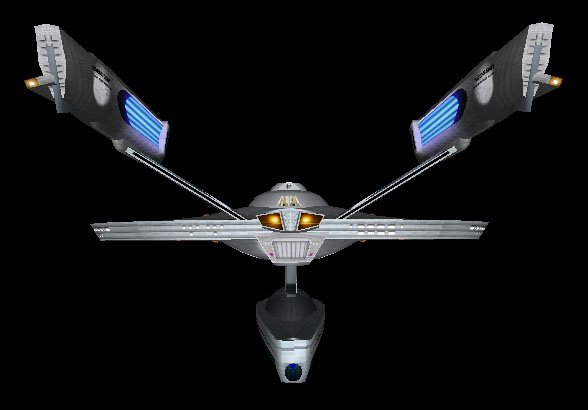 A case study was made on the specific example of the Oberth class’ layout. While being 150m long*, most of that length is the huge "secondary hull" of the Oberth, which is actually just a massive sensor arrray**. It holds Deck 5 of the ship, which is really just an access walkway that gives physical access to the myriad of sensor packages mounted there for repairs, maintenance, and physical reconfiguring or removal of components. The forward end of Deck 5 also houses the ship's only photon torpedo tube/probe launcher. In a highly unusual design decision, Deck 5 is only accessible by Jeffries Crawl Tubes down the pylons, or by short-range transporter. There is no turbolift or standard stairwell access. It was implemented this way as it was envisioned that there would be very little use made of “Deck 5”.
A case study was made on the specific example of the Oberth class’ layout. While being 150m long*, most of that length is the huge "secondary hull" of the Oberth, which is actually just a massive sensor arrray**. It holds Deck 5 of the ship, which is really just an access walkway that gives physical access to the myriad of sensor packages mounted there for repairs, maintenance, and physical reconfiguring or removal of components. The forward end of Deck 5 also houses the ship's only photon torpedo tube/probe launcher. In a highly unusual design decision, Deck 5 is only accessible by Jeffries Crawl Tubes down the pylons, or by short-range transporter. There is no turbolift or standard stairwell access. It was implemented this way as it was envisioned that there would be very little use made of “Deck 5”.
The Saucer section is a bare 60m in diameter and contains a mere 4 decks, including the long, flat section that mounts the saucer and the warp nacelles. That long flat deck is the Engineering deck, and has no scientific or crew-related facilities behind the rim of the saucer. Within the habitable Saucer section, 3 small bay cutouts are visible around the saucer circumference. The one at the 12 o’clock position in front is the tiny shuttlebay, holding a single shuttlecraft. The two bays at the 3 and 9 o'clock positions are access doors for two small cargo bays. Each holds a single workbee, but no more shuttles. Further to that are the bridge module, escape pods, crew quarters, sickbay, laboratories, and some very limited recreational facilities, all vying for space within the confines of the saucer’s 4 decks. The study came to the conclusion that a far bigger habitable section would be greatly desirable in a ship assigned to an extended duration mission with broad appeal. The additional space could be used for increased laboratory space, recreational facilities, and allow the embarking of a far larger complement of scientists, though the crew would only increase slightly.
With the Organian Peace Treaty in effect between the Klingons and the Federation, civilian missions began increasing in regularity and volume through the 2270s. There were many fascinating stellar phenomena within the Klingon sphere of influence that scores of civilian institutions from across the Federation and many friendly non-aligned worlds were interested in, and the number of petitions to the Federation Science Council for expeditions began to reach fever pitch. It was decided to implement the proposals of the aforementioned study and create a dedicated science cruiser for extended duration science missions away from “shore leave” opportunities.
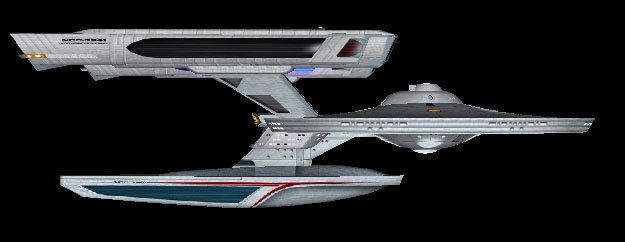 T’lani-class
T’lani-class
With the request from the Federation Science Council, backed by their Oberth Case Study data, Starfleet R&D quickly came up with the ideal solution. Since the only problem was a lack of habitable/usable space, they would attach the superb Oberth-class sensor pallet to a standard-sized Class 1B starship saucer and nacelles. The internal arrangement of the saucer was reconfigured to give private cabins with built-in workstations for a maximum of 200 scientists as well as extensive recreational and “downtime” facilities on Decks 5 & 6. Private cabins for a maximum of 50 crew were sited on Deck 4, and Decks 2 & 3 were configured as the crew’s administrative centre, with 2 extra docking ports for personnel transfers. Decks 7 through 11 are almost exclusively dedicated to scientific facilities such as sensor arrays, laboratories, library computer rooms, real-time data uplinks to other institutions and facilities, and probe control rooms, though Deck 7 also houses sickbay, transporters, and the small cargo bays.
Engineering consists of most of the aft section of Deck 6, where an modified destroyer-type warp reactor is mounted flush with the upper surface of the saucer forward of the impulse deflection crystal. For the coupling of the Oberth sensor pallet to the saucer section, a few variations were tried. The original plan to use the Oberth pylons was quickly discarded and it was agreed upon to use a destroyer-style dorsal neck, for the same reasons given above: it was deemed wasteful of power to beam down 10 metres to the sensor array, and civilian scientists may have objected to getting themselves dishevelled crawling down the curved, zero-g Jeffries Tubes. With the use of a dorsal neck, stairwell and turbolift access could be provided, as could additional conference rooms and viewing galleries. It was decided fairly late on to add a full-sized shuttle bay to the design, but it was deemed that a science cruiser should have the ability to carry a scientific shuttle or two as well. A fully equipped bay with 2 shuttle capacity was mounted at the top of the dorsal neck at the rear edge, and allowed the storage of several more travel pods.
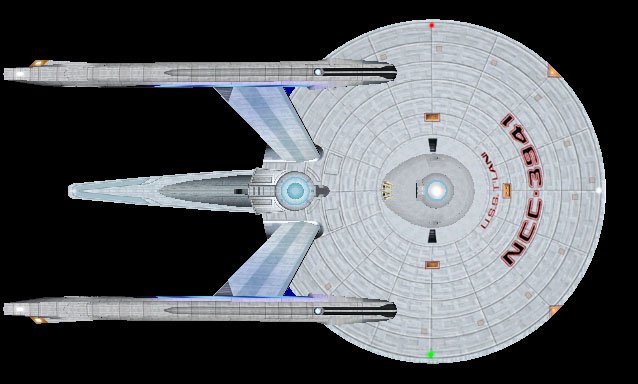 For defence, the standard saucer phaser complement of 6 banks of twin emitters is included, though they are downgraded from heavy cruiser grade Type-VI to defensive Type--IV phasers. The standard Oberth-class photon torpedo arrangement and complement is included, with 10 torpedoes firing from the probe launcher at the front of the sensor pallet. A standard destroyer-level shield grid is mounted. With the destroyer-level power plant and SIF this vessel is capable of warp 6 cruising and warp 8 emergency speeds, and her sensor range is increased 200% over that of the standard Oberth, though maximum resolution is the same. With the reduction of the tactical suite to Type 3 defences only, the extensive top and bottom saucer sensor emplacements were deemed unnecessary. The exploratory sensor suite of the Tikopai class was installed as standard.
For defence, the standard saucer phaser complement of 6 banks of twin emitters is included, though they are downgraded from heavy cruiser grade Type-VI to defensive Type--IV phasers. The standard Oberth-class photon torpedo arrangement and complement is included, with 10 torpedoes firing from the probe launcher at the front of the sensor pallet. A standard destroyer-level shield grid is mounted. With the destroyer-level power plant and SIF this vessel is capable of warp 6 cruising and warp 8 emergency speeds, and her sensor range is increased 200% over that of the standard Oberth, though maximum resolution is the same. With the reduction of the tactical suite to Type 3 defences only, the extensive top and bottom saucer sensor emplacements were deemed unnecessary. The exploratory sensor suite of the Tikopai class was installed as standard.
U.S.S. K'welix, NCC-3947
Commander Remus Geris in command (Tellarite male).
With Rigelian female First Officer Ketaka Liminis.
Deltan male science officer Aatyii
Caitian male Communications Officer Fzzitz – left his mundane life behind on Cait to explore the Federation and beyond. Hungry for a challenge, Fzzitz specialised in communications, his exceptional hearing allowing him to detect sounds outside of the range of a human. No matter the scientific specialisation, he is still a Caitian and more than capable of fending for himself in unarmed combat – one of the factors for his selection for this mission. He has studied the linguistic data for the Taubat and is ready to translate any artefacts that are found.
Andorian female zhen Engineer
Betazoid male Chief Medical Officer Lum Mertis. Studied at the University of Betazed and comparative studies at Vulcan and Cait. Mertis is the master of Taubat physiology and has studied the records of Taubat and Metar biology. Mertis finds the Taubat creation by the Metar fascinating and cannot wait to study living examples firsthand, no matter the risks.
Andorian male thaan FSMC/Security Operations chief th’chengan (complete with contingency of 30 marines). Sparring partner with the Klingon doctor. Good verbal sparring on combat abilities as well. Protection unit for the scientists in light of hunting Taubat and their vicious masters.
Aenar male xeno-psychologist Doctor Kesab. One of the Federation’s primary consultants on Taubat and Metar mentality. The doctor was brought in as a young, idealistic medical school graduate for studying the Tabula Rasa systems and ended up as one of their most valuable personnel.
and Saurian female Helmsman Lypiss.
Also Romulan Doctor N’zena. Female Romulan, most likely Tal Shiar operative. The Romulan representative keeps herself mostly isolated. Too many clashes with her people and the Federation races have made her position ‘difficult’. If questioned, she espouses the superiority of her race and nation. Whilst curious about the mission and helpful on the projects, one is left with a certain feeling that she is manipulating her conversations and relations to get as much information for her own gain as possible. The Aenar doctor Kesab is aware of her devious nature but she can cloud her thoughts enough to hide her exact orders.
And Klingon Doctor J’dob. J’dob may be a Klingon who specialises in the Metar race, but this makes him no less of a scholar in all things Klingon cultural and philosophical. He has read many of the works of Kahless that lesser scholars know little of, and will readily compare the words of Kahless with the guiding principles of other cultures – usually to find fault in those that contradict the Klingon pioneer. J’dob is adept at Klingon martial arts and bladed weapons, although these are carefully controlled (as best as possible) by the security team on the K’welix.
Mission:
Sent out to the underbelly of the Beta Quadrant to study spatial phenomenon and investigate sightings of new life-forms. What the mission does not expressly clarify is the ship is on the hunt for the Taubat who escaped from the Tabula Rasa phenomenon. Starfleet is trying to keep the hunt low-key to avoid public panic and to contain the situation. This T’lani class ship was chosen for its range and capabilities.
Starfleet Tacfleet has assets discreetly shadowing the K’welix and other scout vessels on this hunt. Some of these vessels include Strider class scouts, Antares class AWACS, Trista class scout and Oberth class. Evidence has been found of Taubat colonies outside of their initial region; this proves that they escaped the interspatial trap. Back-channel communications with the Romulans and Klingons on the matter resulted in sightings of Romulan science ships and a Bird of Prey being tracked in the region.
The K’welix is unique in that the crew includes both civilians from Starfleet scientific establishments and personnel from the Klingon and Romulan nations. Such is the importance of the Taubat mission that the President of the UFP signed off on including non-Federation representatives in the name of openness and transparency in the hunt. The inclusion of the two non-Federation members has caused some friction and ‘unique angles’ on situations. Despite the closing of the Romulan borders in 2311, their representative remains onboard the K’welix.
The other race that has been spotted are examples of the Peladine Republic outside of the Lyran Star Empire. The Federation Council has chosen not to inform the Lyrans on the grounds of non-interference and the fact that Peladine races are kept in zoos and slavery by the Lyrans.
Author notes:
K’welix – a Rigelian explorer from a century ago who is famous for his diary.
Taubat come from Star Trek: New Worlds (2000).
T'Lani class credits:
Creator of class and history: Scottish Andy
Kitbasher: Scottish Andy
Minor Retexturing: Scottish Andy
Scale: Scottish Andy
Hardpoints & Damage Points: untouched
Models & Textures used: Atrahasis’ Tikopai class, p81’s Oberth class, Lord Schtupp’s shuttlebay (for Atrahasis & Firesoul’s Salazar-class).









 History - Development of the Science Cruiser Concept
History - Development of the Science Cruiser Concept A case study was made on the specific example of the Oberth class’ layout. While being 150m long*, most of that length is the huge "secondary hull" of the Oberth, which is actually just a massive sensor arrray**. It holds Deck 5 of the ship, which is really just an access walkway that gives physical access to the myriad of sensor packages mounted there for repairs, maintenance, and physical reconfiguring or removal of components. The forward end of Deck 5 also houses the ship's only photon torpedo tube/probe launcher. In a highly unusual design decision, Deck 5 is only accessible by Jeffries Crawl Tubes down the pylons, or by short-range transporter. There is no turbolift or standard stairwell access. It was implemented this way as it was envisioned that there would be very little use made of “Deck 5”.
A case study was made on the specific example of the Oberth class’ layout. While being 150m long*, most of that length is the huge "secondary hull" of the Oberth, which is actually just a massive sensor arrray**. It holds Deck 5 of the ship, which is really just an access walkway that gives physical access to the myriad of sensor packages mounted there for repairs, maintenance, and physical reconfiguring or removal of components. The forward end of Deck 5 also houses the ship's only photon torpedo tube/probe launcher. In a highly unusual design decision, Deck 5 is only accessible by Jeffries Crawl Tubes down the pylons, or by short-range transporter. There is no turbolift or standard stairwell access. It was implemented this way as it was envisioned that there would be very little use made of “Deck 5”. T’lani-class
T’lani-class For defence, the standard saucer phaser complement of 6 banks of twin emitters is included, though they are downgraded from heavy cruiser grade Type-VI to defensive Type--IV phasers. The standard Oberth-class photon torpedo arrangement and complement is included, with 10 torpedoes firing from the probe launcher at the front of the sensor pallet. A standard destroyer-level shield grid is mounted. With the destroyer-level power plant and SIF this vessel is capable of warp 6 cruising and warp 8 emergency speeds, and her sensor range is increased 200% over that of the standard Oberth, though maximum resolution is the same. With the reduction of the tactical suite to Type 3 defences only, the extensive top and bottom saucer sensor emplacements were deemed unnecessary. The exploratory sensor suite of the Tikopai class was installed as standard.
For defence, the standard saucer phaser complement of 6 banks of twin emitters is included, though they are downgraded from heavy cruiser grade Type-VI to defensive Type--IV phasers. The standard Oberth-class photon torpedo arrangement and complement is included, with 10 torpedoes firing from the probe launcher at the front of the sensor pallet. A standard destroyer-level shield grid is mounted. With the destroyer-level power plant and SIF this vessel is capable of warp 6 cruising and warp 8 emergency speeds, and her sensor range is increased 200% over that of the standard Oberth, though maximum resolution is the same. With the reduction of the tactical suite to Type 3 defences only, the extensive top and bottom saucer sensor emplacements were deemed unnecessary. The exploratory sensor suite of the Tikopai class was installed as standard.




